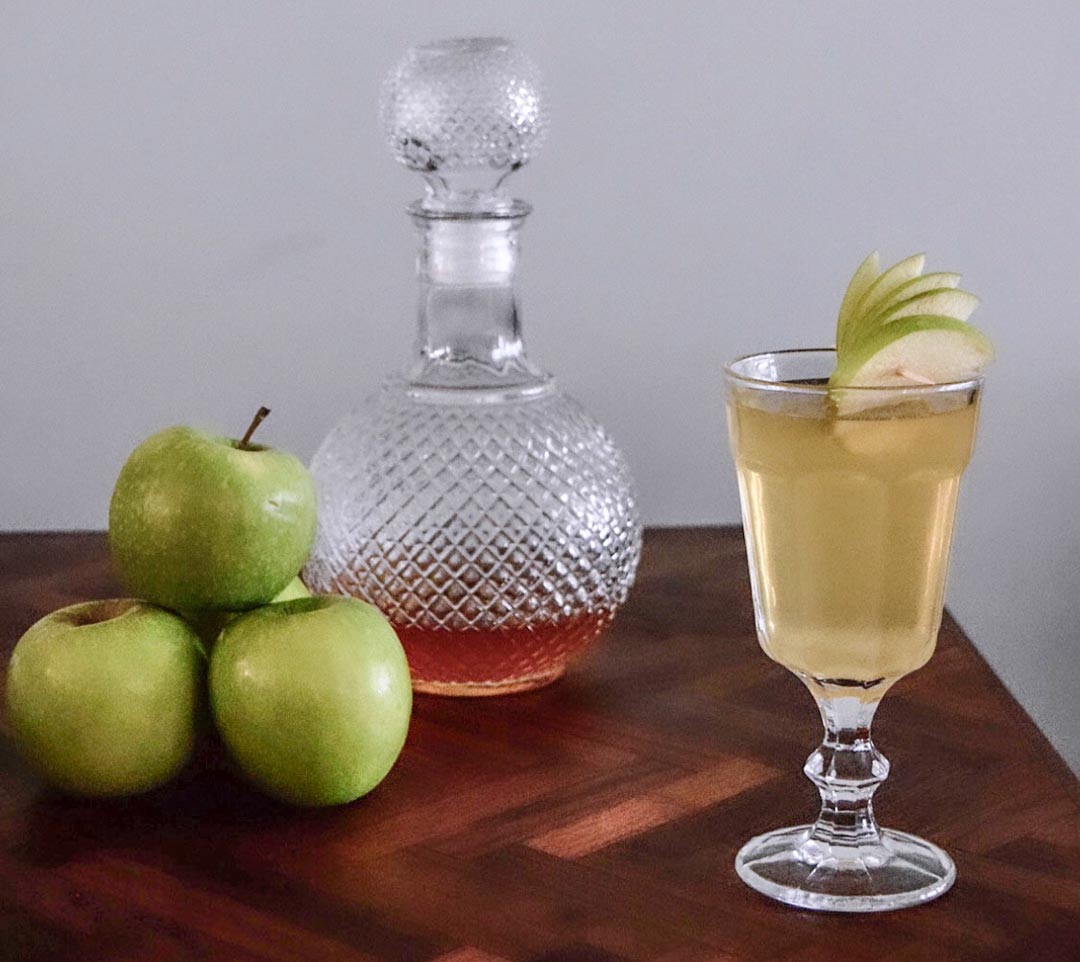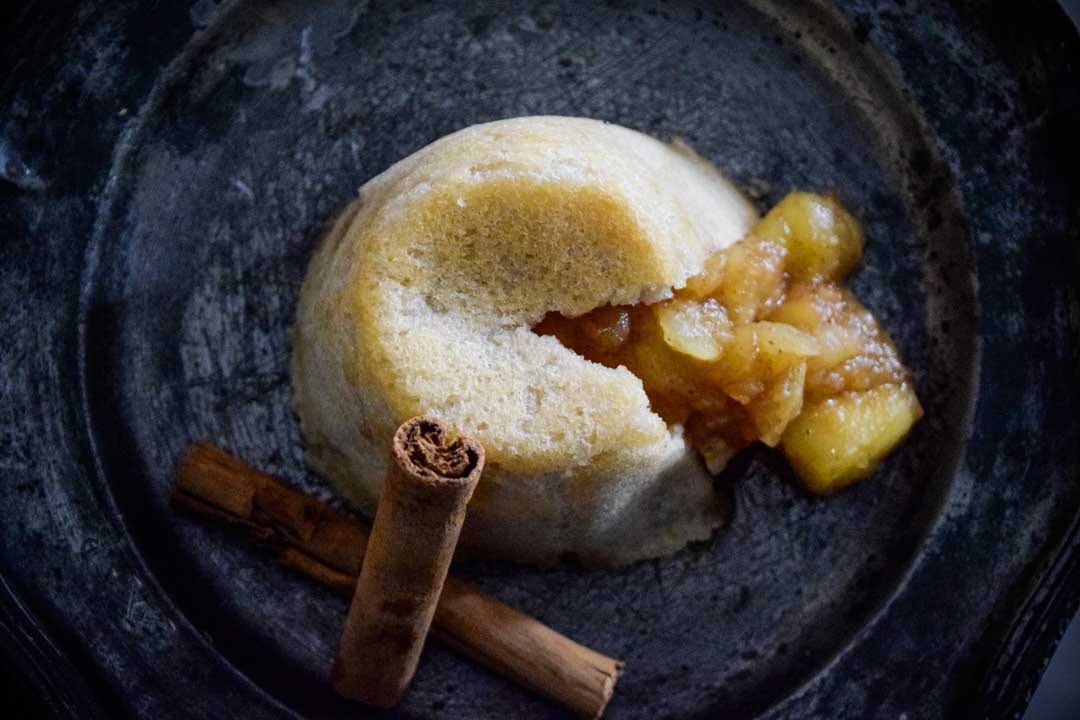The Apple: Served Three Ways
A taste of apples through time, with three historical recipes
Delving into her own cookery book collection, Tasha Marks, food historian and founder of AVM Curiosities, presents a taste of apples through time. With three historical recipes, tried, tested and adapted for the contemporary kitchen.
Whether you fancy a 1920s tipple or a taste of Ancient Rome, make sure to post a picture of your apple creation on your Instagram, Twitter or Facebook, with the hashtag #appleservedthreeways.
Drink | Cocktail
Good Housekeeping Cookery for Invalids (1926)
Apple Toddy
There are not many drinks that could be considered to have both medicinal and festive applications, but a Hot Toddy is one of them. It’s not known exactly where the Toddy originated from, but in Britain it’s a popular curative recipe from the 18th century onwards.
Hot Toddies are found in numerous publications on so called ‘Invalid Cookery’, including the Good Housekeeping Cookery for Invalids (1926) by Florence B. Jack, from where this ‘Apple Toddy’ recipe has been adapted. This libation celebrates the humble Granny Smith, and is recommended to stave off any seasonal sniffles, or as a welcome warming concoction on a cold winter’s night.
Ingredients:
- 2 Granny Smith Apples (or similar)
- ½ Lemon (zest and juice)
- 4 tsp Caster Sugar
- 1 pint Boiling Water
- 50ml Whiskey (to taste)
Method:
- This is a recipe of two parts; first you have to make the Apple Water, which must be left to cool for several hours, then you make the Apple Toddy.
- To make the Apple Water, finely chop two Granny Smith apples (or similar ‘juicy apples with a sharp flavour’), leaving on the skin, but removing the core.
- Place the sliced apple into a jug with the zest and juice of half a lemon, four teaspoons of sugar and a pint of boiling water.
- Cover and leave to cool.
- Once at room temperature, strain the mixture through a sieve and either use immediately or store the remaining liquid in the fridge.
- To make your Apple Toddy, heat around 250ml of Apple Water with 50ml of whiskey in a saucepan (gin can be used instead of whiskey if preferred).
- Serve steaming hot in a mug or heat-proof glass.
- Garnish with a slice of apple.
Serves 2-4
Main Course
Apicius, 1st century AD
Pork with Apple
This ancient Roman dish is an adaptation of a recipe from De re culinaria (On the Subject of Cooking) by Apicius. This collection of Roman cookery recipes is thought to have been compiled in the 1st century AD, making it around 2,000 years old.
With an ancient recipe such as this, there were a few barriers to overcome: firstly, the translation, which I found in The Classical Cookbook published by the British Museum – this publication also gave me a great leg up when it came to the modern recipe, as I started with their suggested method and tweaked for my version.
The other obstacle is more subjective, but it comes down to our changing tastes. The Romans loved their sweet and sour flavours – which have more parallels today with Asian as opposed to European dishes. But once you come to understand the Romans’ way of seasoning – honey for sweetness, vinegar for sour – it opens up a whole new world of intense savoury flavours.
Ingredients:
- 600g Pork shoulder steak
- 350g Pork meatballs
- 3 tbsp Greek clear honey
- 1 Bay leaf
- 1 tsp Whole peppercorns
- 1 Large leek
- 1 Large handful of coriander (roughly torn)
- 4 Braeburn apples (or similar)
- 200ml White wine
- 100ml Apple cider vinegar
- 30ml Olive oil
- 75ml Fish sauce
- 3 tsp Ground cumin
- 3 tsp Ground coriander
- 1 tsp Asafoetida powder
- 2tsp Finely chopped fresh mint
- 3tsp Cornflour
Method:
- Put your pork shoulder steaks in a large saucepan with 500ml of water (or enough to cover the steaks), plus 1 tbsp of honey, a bay leaf and 1 tsp of whole peppercorns.
- Bring to the boil and simmer for 1 hour. Top up with water where necessary.
- Remove the pork from the broth and add to the liquid your white wine, apple cider vinegar, olive oil, fish sauce and 2 tbsp of honey.
- While you wait for that to the boil, dice your pork steaks, chop up your leeks and peel, core and slice your apples.
- Add your meatballs to the broth, along with 3tsp of ground coriander, 3 tsp ground cumin and 1 tsp asafoetida.
- Once boiling again, add your chopped ingredients: the leeks, diced pork and apples.
- Simmer for 30 minutes or until the meatballs are cooked through.
- Add cornflour to thicken the stew, plus a large handful of torn coriander (including the stalks) and 2 tsp of finely chopped mint leaves.
- Serve hot with an accompaniment of your choice and garnish with more fresh coriander.
Serves 2-4
Dessert
Mrs Beeton’s Cookery Book (1861)
Apple Charlotte
While this dish was purportedly invented for Princess Charlotte of Wales by the infamous Victorian chef, Marie-Antoine Carême, it was Mrs Beeton’s recipe which was my first introduction to the Apple Charlotte. My version is fairly true to the entry in Mrs Beeton’s Cookery Book of 1861, but I have taken the liberty of adding some cinnamon to the apple mix, which I hope Mrs Beeton would forgive me for.
This version also uses four individual pudding basins rather than one large one – but if you don’t have these you can use a deep muffin tray instead. This is a classic 19th century recipe, which contains only simple ingredients. It is an affordable piece of showmanship, perfect for a dinner party, special occasion, or even just a Wednesday night.
Ingredients:
- 3 Cooking Apples – medium-sized, peeled, cored and chopped into 2cm cubes
- ½ Lemon (zest & juice)
- 4 tbsp Light Brown Sugar
- ½ tsp Ground Cinnamon
- 1 loaf White Bread (sliced with crusts removed)
- 100g Unsalted Butter (softened or spreadable)
Method:
- First make your apple filling, by heating the apples, sugar, lemon juice, lemon zest and cinnamon, along with 1 tbsp water, in a saucepan.
- Cover and cook over a low-medium heat for 5-10 mins, or until the apples are easily squashed with a spoon. Pulp about half the mixture with a spoon, but make sure to leave many of the apple pieces whole for texture.
- Next, liberally butter your mini pudding basins, then line with buttered white bread. The buttered side of the bread should face inwards as the tin is already buttered.
- Line your pudding basins by first cutting a buttered bread circle for the base, then cut the rest into strips and place vertically in the pudding basin – making sure to overlap to create a solid crust and pushing down firmly to form a case.
- Fill nearly to the top with your stewed apples – but do not overfill – and place a final disc of buttered bread on top, pressing down to form a seal.
- Repeat this process to create four puddings.
- Place the puddings in the oven at 180C for 20 minutes, with the bottom side up but weighed down with another baking tray.
- After 20 minutes, check that the bottom in nicely golden and turn out immediately onto your serving plates.
- Serve hot with cream or custard.
Serves 2-4







 Apples at the Museum of Cider, Hereford by Christopher Preece www.InfinityUnlimited.co.uk
Apples at the Museum of Cider, Hereford by Christopher Preece www.InfinityUnlimited.co.uk Copyright © Conaald 2021
Copyright © Conaald 2021